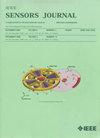织物基板柔性传感器用超薄金属导电层的热回流转移印刷
IF 4.3
2区 综合性期刊
Q1 ENGINEERING, ELECTRICAL & ELECTRONIC
引用次数: 0
摘要
织物基板具有机械灵活性,透气性和纺织品兼容性,使其成为可穿戴传感器的理想选择。然而,它们的多孔和不规则表面给集成超薄、高导电性金属层带来了挑战,这对于柔性电子产品的导电性和信号传输至关重要。传统的技术难以在这种基板上精确沉积和均匀覆盖。在这里,我们提出了一种热回流转移印刷技术,使用焦糖-玉米糖浆混合物作为可回流转移介质。在温和的加热下,这种糖基邮票转变成橡胶状态,使金属层无缝地符合织物表面。利用这种方法,我们成功地在织物衬底上印刷了大面积30 nm厚的超薄金电极,实现了$6.0\times 10^{-{8}}~\Omega \cdot $ m的低电阻率,并且在弯曲下具有出色的机械灵活性。作为应用演示,我们在织物衬底上使用转移的互指金电极制造和测试了湿度和压力传感器。测量结果表明,这些传感器具有良好的灵敏度、可靠性和稳定性。转移打印方法的多功能性,加上转移金属层的卓越性能,使其成为下一代可穿戴传感技术发展的有前途的解决方案。本文章由计算机程序翻译,如有差异,请以英文原文为准。
Thermal Reflow Transfer Printing of Ultra-Thin Metal Conductive Layer for Flexible Sensors on Fabric Substrate
Fabric substrates offer mechanical flexibility, air permeability, and textile compatibility, making them ideal for wearable sensors. However, their porous and irregular surfaces pose challenges for integrating ultra-thin, highly conductive metal layers, which are essential for electrical conductivity and signal transmission in flexible electronics. Conventional techniques struggle with precise deposition and uniform coverage on such substrates. Here, we present a thermal reflow transfer printing technique using a caramel-corn syrup mixture as a reflowable transfer medium. Under mild heating, this sugar-based stamp transitions into a rubbery state, enabling the metal layer to conform seamlessly to the fabric surface. Using this method, we successfully printed large-area 30 nm-thick ultra-thin gold electrodes onto fabric substrates, achieving low resistivity of $6.0\times 10^{-{8}}~\Omega \cdot $ m and outstanding mechanical flexibility under bending. As application demonstrations, we fabricated and tested humidity and pressure sensors using the transferred interdigitated gold electrodes on fabric substrates. The measurements confirm the good sensitivity, reliability, and stability of these sensors. The versatility of the transfer printing method, combined with the outstanding properties of the transferred metal layers, makes it a promising solution for the development of next-generation wearable sensing technologies.
求助全文
通过发布文献求助,成功后即可免费获取论文全文。
去求助
来源期刊

IEEE Sensors Journal
工程技术-工程:电子与电气
CiteScore
7.70
自引率
14.00%
发文量
2058
审稿时长
5.2 months
期刊介绍:
The fields of interest of the IEEE Sensors Journal are the theory, design , fabrication, manufacturing and applications of devices for sensing and transducing physical, chemical and biological phenomena, with emphasis on the electronics and physics aspect of sensors and integrated sensors-actuators. IEEE Sensors Journal deals with the following:
-Sensor Phenomenology, Modelling, and Evaluation
-Sensor Materials, Processing, and Fabrication
-Chemical and Gas Sensors
-Microfluidics and Biosensors
-Optical Sensors
-Physical Sensors: Temperature, Mechanical, Magnetic, and others
-Acoustic and Ultrasonic Sensors
-Sensor Packaging
-Sensor Networks
-Sensor Applications
-Sensor Systems: Signals, Processing, and Interfaces
-Actuators and Sensor Power Systems
-Sensor Signal Processing for high precision and stability (amplification, filtering, linearization, modulation/demodulation) and under harsh conditions (EMC, radiation, humidity, temperature); energy consumption/harvesting
-Sensor Data Processing (soft computing with sensor data, e.g., pattern recognition, machine learning, evolutionary computation; sensor data fusion, processing of wave e.g., electromagnetic and acoustic; and non-wave, e.g., chemical, gravity, particle, thermal, radiative and non-radiative sensor data, detection, estimation and classification based on sensor data)
-Sensors in Industrial Practice
 求助内容:
求助内容: 应助结果提醒方式:
应助结果提醒方式:


